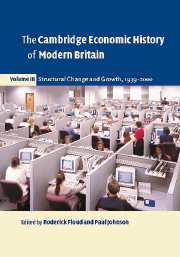Book contents
- Frontmatter
- Chapter 1 The war-time economy, 1939–1945
- Chapter 2 Failure followed by success or success followed by failure? A re-examination of British economic growth since 1949
- Chapter 3 The performance of manufacturing
- Chapter 4 A failed experiment: the state ownership of industry
- Chapter 5 Employment, education and human capital
- Chapter 6 Money and monetary policy since 1945
- Chapter 7 The financial services sector since 1945
- Chapter 8 Economic policy
- Chapter 9 The welfare state, income and living standards
- Chapter 10 The rise of the service economy
- Chapter 11 Impact of Europe
- Chapter 12 Technology in post-war Britain
- Chapter 13 Regional development and policy
- Chapter 14 British fiscal policy since 1939
- Chapter 15 Industrial relations and the economy
- References
- Index
- References
Chapter 8 - Economic policy
Published online by Cambridge University Press: 28 March 2008
- Frontmatter
- Chapter 1 The war-time economy, 1939–1945
- Chapter 2 Failure followed by success or success followed by failure? A re-examination of British economic growth since 1949
- Chapter 3 The performance of manufacturing
- Chapter 4 A failed experiment: the state ownership of industry
- Chapter 5 Employment, education and human capital
- Chapter 6 Money and monetary policy since 1945
- Chapter 7 The financial services sector since 1945
- Chapter 8 Economic policy
- Chapter 9 The welfare state, income and living standards
- Chapter 10 The rise of the service economy
- Chapter 11 Impact of Europe
- Chapter 12 Technology in post-war Britain
- Chapter 13 Regional development and policy
- Chapter 14 British fiscal policy since 1939
- Chapter 15 Industrial relations and the economy
- References
- Index
- References
Summary
INTRODUCTION
From 1931 the possibility of much greater management of the national economy was opened up by the departure from gold, the imposition of tariffs and, at the micro-economic level, the willingness of government to encourage cartels and price-fixing. Together these policies enabled the pursuit of a loose-coupled strategy of raising prices in order to increase profits and hence, it was hoped, investment (Booth 1987). The war added a major impetus to this rise of national economic management (NEM). On the one hand, it greatly reinforced the political necessity for governments to offer economic security and betterment to their citizens, not least because the political support for a capitalist economy had been shaken by the interwar depression and now faced a potent ideological enemy in the Soviet system. Simultaneously, the war enormously enlarged the capacity of government, increasing the spending and taxing power, but also instituting a range of direct controls which meant that by 1945 we can sensibly talk about a semi-planned economy in Britain, albeit one in which the planning mechanisms were very much tied to the exigencies of wartime shortages (see chapter 1 above).
While there was some retreat from the intensive wartime controls in the later part of the Attlee period (1945-51), the belief that government’s prime domestic purpose was to manage the economy persisted for the rest of the twentieth century, largely surviving even after the alleged ‘retreat from economic management’ of the late 1970s and 1980s. This high level of government activity has generated in its wake an enormous volume of scholarly comment and analysis.
- Type
- Chapter
- Information
- The Cambridge Economic History of Modern Britain , pp. 189 - 212Publisher: Cambridge University PressPrint publication year: 2004
References
- 4
- Cited by

